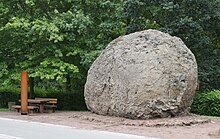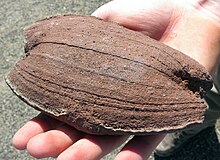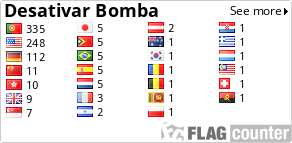Bomba vulcânica
Uma bomba vulcânica é um tipo de piroclasto formado quando um vulcão expele fragmentos viscosos de lava durante uma erupção. Estes fragmentos arrefecem até solidificar antes do embate com o solo. As bombas vulcânicas podem ser lançadas a vários quilómetros de distância do local de erupção, adquirindo frequentemente formas aerodinâmicas durante o voo. Podem ser de grandes dimensões: a erupção de Asama, no Japão, em 1935, expeliu bombas a distâncias até 600 m da chaminé vulcânica. As bombas vulcânicas são um dos perigos significativos associados ao vulcanismo, podendo causar ferimentos graves e até a morte a pessoas que se encontrem na zona de erupção. Um incidente deste tipo ocorreu na inesperada erupção do vulcão Galeras na Colômbia em 1993: seis pessoas que se encontravam no cume morreram e várias ficaram feridas com gravidade por bombas vulcânicas. As bombas vulcânicas são classificadas quanto à sua forma, determinada pela fluidez do magma a partir do qual se formam.

Uma bomba vulcânica em Strohn, Renânia-Palatinado, Alemanha, descoberto em 1969, pesa cerca de 120 toneladas e tem um diâmetro de 5 metros. Foi emitido durante uma erupção vulcânica em 8300 a.C.

Uma bomba vulcânica fusiforme.
Tipos de Bombas
Bombas cilíndricas ou em fita
Estas bombas formam-se a partir de magma moderadamente ou bastante fluido, expelido como fios de forma irregular e bolhas. Os fios quebram-se em segmentos que caem no solo intactos e se assemelham a fitas. Tais bombas são circulares ou de secção chata, apresentam estrias longitudinais e vesículas laminares.
Bombas esféricas
Estas bombas também se formam a partir de magma fluido. No caso das bombas esféricas, a tensão superficial é suficiente para manter a forma esférica do material expelido.
Bombas fusiformes
As bombas fusiformes são formadas pelo mesmo processo que as esféricas, diferindo principalmente na sua forma. Estas bombas entram em rotação durante o voo, o que lhes confere um aspecto alongado (em forma de amêndoa). Apresentam estrias longitudinais, com um dos lados mais liso e largo que o outro, que corresponde ao lado inferior da bomba na queda.
Bombas "bosta de vaca"
Estas bombas são formadas quando magma muito fluido cai de curtas alturas, de modo que a bomba não solidifca completamente antes do impacto. As bombas espalham-se no solo formando discos arredondados irregulares que se assemelham a bostas de vaca.
Bombas "crosta de pão"
Se a parte externa da bomba arrefece durante o voo, pode desenvolver uma superfície gretada enquanto o interior se expande. Este tipo de bomba é por isso chamada "crosta de pão".
Bombas cored (nucleadas)
São bombas com camadas de lava cobrindo um núcleo de lava previamente consolidado. O núcleo consiste de fragmentos acessórios de erupções anteriores, fragmentos acidentais de rocha nativa ou, em casos raros, lava formada anteriormente na mesma erupção.
Esta EarthCache está situada perto da praia de São Julião, na Ericeira. O acesso é fácil, mas deve ter algum cuidado na abordagem final, especialmente em dias chuvosos e com vento ou com mar agitado. Por favor, tome cuidado especial com as crianças!
Para registrar esta Eartcache terá que visitar o GZ e responder às seguintes questões:
-
Qual o tamanho mínimo de uma massa de rocha fundida, originada num vulcão, para que seja chamada de "bomba vulcânica"? (procure na net)
-
Qual o tamanho da bomba vulcânica no GZ? (medida de baixo para cima na parte mais ocidental da bomba vulcânica)
-
Classificaria a bomba vulcânica em pequena, média ou grande e por quê?
-
Que tipo de bomba vulcânica encontrou no GZ? (por exemplo, "crosta de pão", "cored", "bosta de vaca”, ...)
-
(opcional) tire uma foto sua no GZ com o mar no fundo (eu amo as ondas ;-), mas não publique as fotos da bomba vulcânica que descobriu aqui.
Envie suas respostas para correiart@gmail.com (português) ou para sunnyhill.Ahrtal@gmail.com (inglês ou alemão). De acordo com as guidelines, você pode efetuar o log on-line depois de enviar suas respostas.
Divirta-se descobrindo nossa terra!!
Agradecimentos especiais para correiart por sua ajuda e tradução. Foi a sua Earth Cache "Fenda do Gaiteiro" GC6101C que me guiou para encontrar esta bomba vulcânica ;-)

![]()
Volcanic bomb
A volcanic bomb is a mass of molten rock, formed when a volcano ejects viscous fragments of lava during an eruption. They cool into solid fragments before they reach the ground. Because volcanic bombs cool after they leave the volcano, they are extrusive igneous rocks. Volcanic bombs can be thrown many kilometres from an erupting vent, and often acquire aerodynamic shapes during their flight. Volcanic bombs are a significant volcanic hazard, and can cause severe injuries and death to people in an eruption zone. One such incident occurred at Galeras volcano in Colombia in 1993; six people near the summit were killed and several seriously injured by lava bombs when the volcano erupted unexpectedly. Volcanic bombs are known to occasionally explode from internal gas pressure as they cool, but in most cases, most of the damage they cause is from impact, or subsequent fire damage. Bomb explosions are most often observed in "bread-crust" type bombs.

Lava bomb at Strohn, Rhineland-Palatinate, Germany, with a diameter of 5 metres and a weight of 120 metric tons. It was caused by a volcanic eruption in 8300 BC.

"Almond" volcanic bomb found in the Cinder Cones region of the Mojave National Preserve.
Bombs are named according to their shape, which is determined by the fluidity of the magma from which they are formed:
Ribbon or cylindrical bombs form from highly to moderately fluid magma, ejected as irregular strings and blobs. The strings break up into small segments which fall to the ground intact and look like ribbons. Hence, the name "ribbon bombs". These bombs are circular or flattened in cross section, are fluted along their length, and have tabular vesicles.
Spherical bombs also form from high to moderately fluid magma. In the case of spherical bombs, surface tension plays a major role in pulling the ejecta into spheres.
Spindle, fusiform, or almond/rotational bombs are formed by the same processes as spherical bombs, though the major difference being the partial nature of the spherical shape. Spinning during flight leaves these bombs looking elongated or almond shaped; the spinning theory behind these bombs development has also given them the name fusiform bombs. Spindle bombs are characterised by longitudinal fluting, one side slightly smoother and broader than the other. This smooth side represents the underside of the bomb as it fell through the air.
Cow pie bombs are formed when highly fluid magma falls from moderate height, so the bombs do not solidify before impact (they are still liquid when they strike the ground). They consequently flatten or splash and form irregular roundish disks, which resemble cow dung.
Bread-crust bombs are formed if the outside of the lava bombs solidifies during their flights. They may develop cracked outer surfaces as the interiors continue to expand.
Cored bombs are bombs that have rinds of lava enclosing a core of previously consolidated lava. The core consists of accessory fragments of an earlier eruption, accidental fragments of country rock or, in rare cases, bits of lava formed earlier during the same eruption.
To find out more about vulcanic bombs try to search the Internet...
This Earth Cache is situated near the beach of São Julião in Ericeira. The access is easy but you should have some caution on the final approach, especially on rainy and windy days or with rough sea. Please take special care of your children!
To log this Earth Cache you have to visit GZ and answer the following questions:
- what size is a mass of molten rock, erupted from a vulcano, to be called a "vulcanic bomb" ? (search the i-net)
- what size is the vulcanic bomb at GZ? (measure from bottom to top at the most western part of the vulcanic bomb)
- would you call the vulcanic bomb a small, medium or large one and why?
- what type of vulcanic bomb did you find at GZ? (e.g. "bread-crust", "cored", "cow pie…)
- (optional) take a foto from yourself at GZ with the sea in the background (I love waves ;-), but do not post pictures of the vulcanic bomb you have discovered here.
Send your answers to correiart@gmail.com (portuguese) or to sunnyhill.Ahrtal@gmail.com (english or deutsch). According to the guidelines you can log online after sending your answers.
Special thanks to correiart for his help, translation and being the Co-owner! It was his Earth Cache "Fenda do Gaiteiro" GC6101C that guided me here to find this volcanic bomb ;-)
Have fun discovering our earth!!
 The most exciting way to learn about the Earth and its processes is to get into the outdoors and experience it first-hand. Visiting an Earthcache is a great outdoor activity the whole family can enjoy. An Earthcache is a special place that people can visit to learn about a unique geoscience feature or aspect of our Earth. Earthcaches include a set of educational notes and the details about where to find the location (latitude and longitude). Visitors to Earthcaches can see how our planet has been shaped by geological processes, how we manage the resources and how scientists gather evidence to learn about the Earth. To find out more click HERE.
The most exciting way to learn about the Earth and its processes is to get into the outdoors and experience it first-hand. Visiting an Earthcache is a great outdoor activity the whole family can enjoy. An Earthcache is a special place that people can visit to learn about a unique geoscience feature or aspect of our Earth. Earthcaches include a set of educational notes and the details about where to find the location (latitude and longitude). Visitors to Earthcaches can see how our planet has been shaped by geological processes, how we manage the resources and how scientists gather evidence to learn about the Earth. To find out more click HERE.

